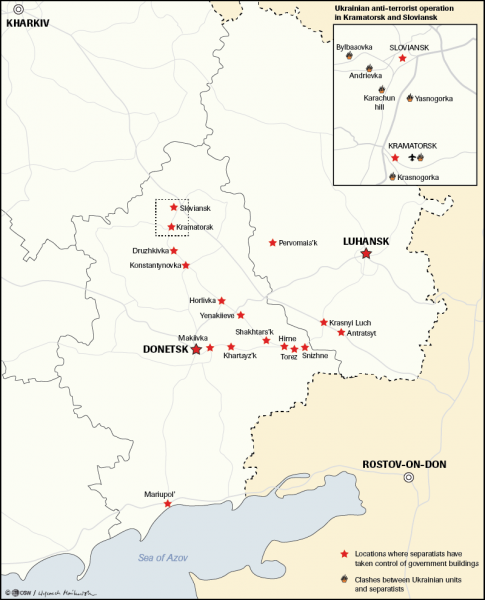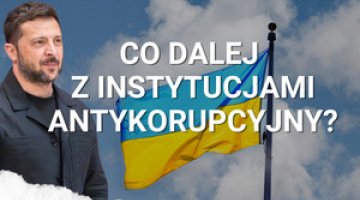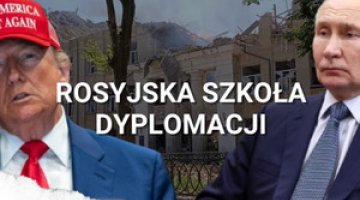Eastern Ukraine: the separatists’ offensive in anticipation of the ‘referendum’
In early May, pro-Russian separatists took control of a succession of towns and cities in eastern Ukraine, including Lugansk and (to a considerable degree) Donetsk. In both of these cities most of the critical state institutions (government buildings, police HQs, the Security Service of Ukraine [SBU], prosecutors’ offices, military units) have fallen under their control. The separatists are also attempting to expand the areas of instability to the southern regions of Ukraine. In Odessa on 2 May, as a result of clashes they provoked against a pro-Ukrainian demonstration, and a subsequent fire in the trade unions building, 46 people were killed. At the same time the separatists are focused on creating their own para-state structures, including an ‘Army of the South East’, and on preparing for a ‘referendum’ to be held on 11 May. Despite President Putin's appeal to the separatists on 7 May to postpone the vote, the conditions they have set to Kyiv were de facto unacceptable, and so on 8 May they confirmed their original plan to hold the ‘referendum’.
The authorities in Kyiv have proved unable to control the rapid expansion of the separatists’ activities, and – in view of the ineffectiveness of the government-led anti-terrorist operation – there is no indication that this will change in the coming weeks. The replacement of officials (heads of the police, governors of districts, etc.) has had no effect, because these people have no influence on the situation on the ground. The passive behaviour, or even open support for the separatists from the local militia confirms the distribution of the power structures in the east, and partly the south, of Ukraine. Kyiv’s sceptical reception to Putin's proposal, together with the Ukrainian authorities’ declared firmness against separatist activities, mean that we should expect a further escalation of the conflict and an increase in the separatists’ subversive activities.
The Donbas (increasingly) under the separatists’ control
At the beginning of May, the separatists stepped up their activities in Lugansk and Donetsk oblasts considerably. Ever more towns and government buildings came under their control, including the armed forces HQ in Lugansk and the seat of the SBU and the prosecutor's office in Donetsk (see map). The separatists met no resistance from the local law enforcement agencies, as a result of the latter’s corruption. Serhiy Taruta, the Kyiv-appointed governor of Donetsk, has proved unable to effectively prevent the further escalation of the situation in the region. The security situation has been further exacerbated by the appearance in several areas of armed troops of Don Cossacks (numbering at least 150 persons).
In addition to reinforcing their positions in the occupied towns, in recent days the separatists have mainly focused on preparing their ‘referendum’ on the status of the Donbas. The most important element is exerting pressure, including threats and violence, on the local authorities to force them to cooperate in organising the vote. In several places in the Donetsk oblast, city and district councils have voluntarily supported the ‘referendum’, and have selected representatives for ‘electoral commissions’. In addition, on 5 May the presidium of the Lugansk region adopted a statement endorsing the holding of the 'referendum'. The preparations for the vote have included the harassment of local pro-Ukrainian political & social activists and journalists.
Attempts to spread the instability to the south
On 2 May in Odessa, where the situation had previously been relatively calm, clashes took place between a several hundred-strong group of separatists and a several thousand-strong group demonstrating in favour of Ukrainian unity. During the demonstration three Ukrainian protesters were shot dead by separatist fighters. The police behaved passively, either not taking any action or openly supporting the separatists. Then pro-Ukrainian demonstrators then destroyed the tent city put up by the separatists, who then took refuge in the trade unions building. In unclear circumstances, a fire broke out in the building (probably from a Molotov cocktail), which resulted in the death of 43 separatists. According to the SBU, the clashes in Odessa were a provocation funded by supporters of Viktor Yanukovych and coordinated by a group of insurgents from Transnistria and Russia. The still incomplete list of victims contains the names of at least three Russian citizens, which would confirm the thesis that Russia was the inspiration for the action. The Interior Ministry stated that the local police bore the responsibility for the events, and dismissed its local leadership.
The government in Kyiv is paralysed
The separatists’ ongoing offensive and the growing threat of destabilisation to successive regions of Ukraine are being accompanied by the incompetence of the central authorities, who are unable to control the situation in the east and prevent further separatist actions. The situation is being further exacerbated by support from regional political elites and some of the local population. However, public sentiment in the Donbas, including the attitudes of the population towards the separatists, are not entirely clear. Opinion polls (carried out by KMIS in mid-April) show that 51.9% and 52.3% respectively of the populations of Lugansk and Donetsk regions favour remaining within Ukraine. At the same time it seems that dissatisfaction with the policy of Kyiv, including the deteriorating socio-economic situation, is rising. In addition, the tragedy in Odessa made a bad impression on the residents of the region, which the separatists and Russian propaganda have exploited to make further accusations against Kyiv. The Ukrainian authorities, because of their own inefficient information policy, have been unable to counterbalance the message from the separatists and Russian media, and as a result have not even attempted to carry out any kind of information campaign in the eastern regions.
The authorities’ weakness and inaction has been accompanied on one hand by attempts to activate some local communities, as demonstrated in the particular case of Odessa, and on the other by the action of Ihor Kolomoysky, the governor of the Dnepropetrovsk region, who prevented the situation in his region from being destabilised. On 11 May he will convene a congress of governors from the south and east of Ukraine (the Donetsk, Lugansk, Zaporozhe, Kherson, Nikolayev and Odessa regions) to coordinate action against separatists as well as preparations in these regions for the presidential elections on 25 May. In addition, the governorship of the Odessa region, after Volodymyr Nemirovsky was fired after holding the position only two months, was given to Ihor Palitsa, who for many years had had close business ties to Kolomoysky, and has been regarded as his man.
Kyiv and the separatists react to Putin’s appealPresident Vladimir Putin’s unexpected call to the separatists to postpone the ‘referendum’ provoked a sceptical reaction from Kyiv. The Ukrainian Prime Minister Arseniy Yatsenyuk stated that the vote would be illegal, and that Kyiv had passed on a ‘road map’ to the OSCE to settle the conflict (although this document has not been published). A statement from the Ukrainian Foreign Ministry was formulated in a similar vein, stating that the Kremlin's rhetoric “has nothing to do with the real search for a way to resolve the crisis”; the essence of the conflict is the aggression by Russia against Ukraine, and it deems the “terrorist referendum” to be illegal. It also stressed that Ukraine’s priority is to launch a national dialogue on a wide scale, but “this cannot be done with terrorists”. At the same time on 7 May in Sloviansk, three SBU employees detained by separatists were exchanged for Pavel Gubariev, the self-proclaimed ‘People's Governor’ of Donetsk, and two other activists of the ‘Donetsk People’s Republic’.
The separatists themselves received Putin’s statement without enthusiasm. Oleh Tsariev, one of the de facto leaders of the separatist movement, said that negotiations with Kyiv are possible, but on the basis of equality of the parties. He also put forward three conditions for starting talks with the government: the immediate cessation of anti-terrorist operations and the return of all army units to their bases; the dissolution of all “illegal military formations”, including the National Guard; and the release of all “political prisoners”. On 8 May, the separatist-run ‘people’s councils’ in the Donetsk and Lugansk regions decided to proceed with plans to hold the ‘referendum’ on 11 May.
Prospects
Regardless of the ‘referendum’s state of readiness it will now be held on 11 May, in order to demonstrate the alleged support of the Donbas for the ‘Donetsk People’s Republic’. After the ‘referendum’, the next goal will be to block the presidential elections in as many constituencies as possible.
Therefore, in the coming days and weeks, a further deterioration of the security situation in the east should be expected, including the takeover by the separatists of more towns and further attempts to destabilise the south of Ukraine. According to reliable reports from the Ukrainian Ministry of Internal Affairs, Crimea and Transnistria are witnessing the recruitment of people to commit acts of terrorism and subversion on the territory of Ukraine. The inefficiency of the central government, the pervasive corruption, and the fact that some officials at various levels are also probably operating as agents for Russia, make it unlikely that the Ukrainian authorities will be able to stabilise the situation in the foreseeable future.
Map
The separatists' actions in eastern Ukraine

This text was closed on 8 May at 12 pm, CET.




